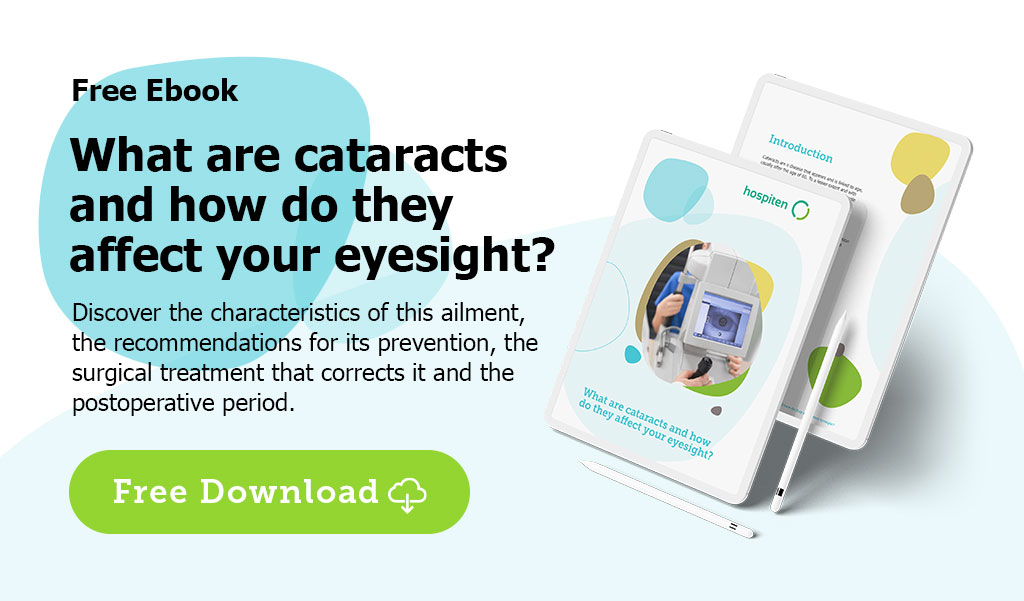If you are over the age of 60 and have experienced a gradual worsening of your vision, it is likely that the cause of your loss of visual acuity is linked to the appearance of cataracts.
Main symptoms linked to cataracts:
- vision loss. Worsening of visual acuity
- difficulty reading and/or seeing up close
- trouble identifying people or their facial expressions
- inability to drive
- difficulty distinguishing license plates or distant objects
- loss of detection of brightness and/or color of objects
- blurred vision
- night glare
- seeing halos around bright spots
- double vision
- photophobia. High sensitivity to light
Although the symptoms of cataracts vary according to their type, there are some common aspects. In most cases, the problem develops slowly, and some of the most common cataract symptoms occur when the patient experiences a gradual loss of vision that becomes more evident in everyday aspects like difficulty reading, problems identifing objects or inability to drive normally.
Blurred vision with images that appear hazy or the sensation of looking through mist reducing the brightness of objects can be linked to cataracts.
With the appearance of cataracts, there is a loss of transparency of the crystalline lens. The accumulation of tissue clouds the lens and light cannot penetrate properly. The effect is similar to living with steamed up glasses, so it is easy to understand why among the most common symptoms are blurred vision or decreased perception of color and brightness of objects.
At the beginning of this post, we mentioned that it is a condition that appears more commonly after the age of 60, however, there are cases of young people, even those under 40, who have suffered from cataracts.
So, in the case you notice any vision problem, it is crucial that you do not self-diagnose or rule out ailments due to your age. Go to an ophthalmologist who can carry out an exhaustive check of your visual health.
Let's continue on the subject of cataracts. There is more than one type of cataract, and although they have symptoms in common like blurred vision, there are a variety of symptoms you may not know about.
Symptoms of cataracts according to their type
Nuclear cataracts
The symptoms of nuclear cataracts focus on a loss of contrast and details in objects, a decrease in the intensity of colors, difficulty in perceiving small objects or difficulty in recognizing people's faces. Nuclear cataracts usually produce a greater loss of visual acuity in distant vision than in near vision. Even good near vision can be preserved, with the ability to read without difficulty.
Cortical cataracts
Cortical cataracts tend to appear at the edges of the lens, so there may be no clear symptoms until the central area of the lens is affected. But the most frequent symptoms of cortical cataracts are difficulty reading and problems with near vision, in addition to being dazzled by lights, especially at night.

Posterior subcapsular cataracts
The symptoms of subcapsular cataracts have certain singularities, like the improvement of vision in dimly lit environments. With this type of cataract there are problems reading and driving during the day. Photophobia, or high sensitivity to light is another of its characteristics.
Summary of possible symptoms of cataracts to help in detection:
- gradual vision loss
- reading difficulties
- trouble recognizing people
- inability to drive
- difficulty distinguishing license plates or distant objects
- loss of perception of brightness and/or color of objects
- blurred vision
- night glare
- vision of halos around bright spots
- double vision
- photophobia
When do the symptoms of cataracts appear?
Nuclear and cortical cataracts usually have slow, gradual evolution, so detecting them in the early stages can be complex. For this reason, you should ideally go for an annual check-up with an ophthalmologist, who will check your state of visual health and make sure that you are not suffering from any diseases.
The most obvious signs of nuclear and cortical cataracts will appear in their more advanced stages, when vision will have deteriorated significantly.
Cataracts and their symptoms cannot be prevented, but medical recommendations can be followed to delay their appearance as much as possible.
Diagnosis of cataracts
Diagnosis of cataracts is usually made with a slit lamp and visual acuity test. The combination of drops to dilate the pupils and an exhaustive examination of the eyeball with the use of the slit lamp to check the transparency of the lens allows the ophthalmologist to detect cataracts.
Once diagnosed, the best treatment to correct cataracts and their symptoms is surgery. In an outpatient procedure, with minimal impact and easy recovery, the surgical team will remove the damaged lens and replace it with a new lens in perfect condition.
This procedure does not require hospitalization. The patient is conscious throughout the process, receiving a little sedation to avoid pain and discomfort. It is a type of intervention that is performed frequently and although there are risks, as in any surgery, the incidence is low.
Post-surgery care is simple, it will mainly consist of the application of drops and protecting the eye from sunlight. In addition to attending check-ups that your ophthalmologist will schedule.
